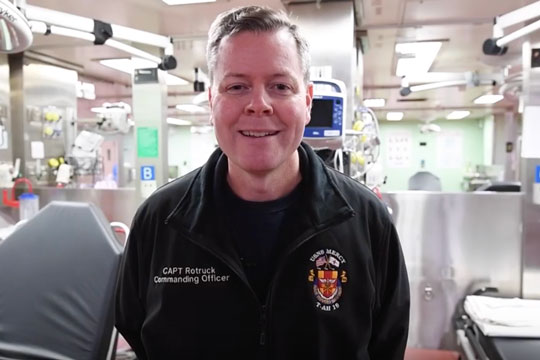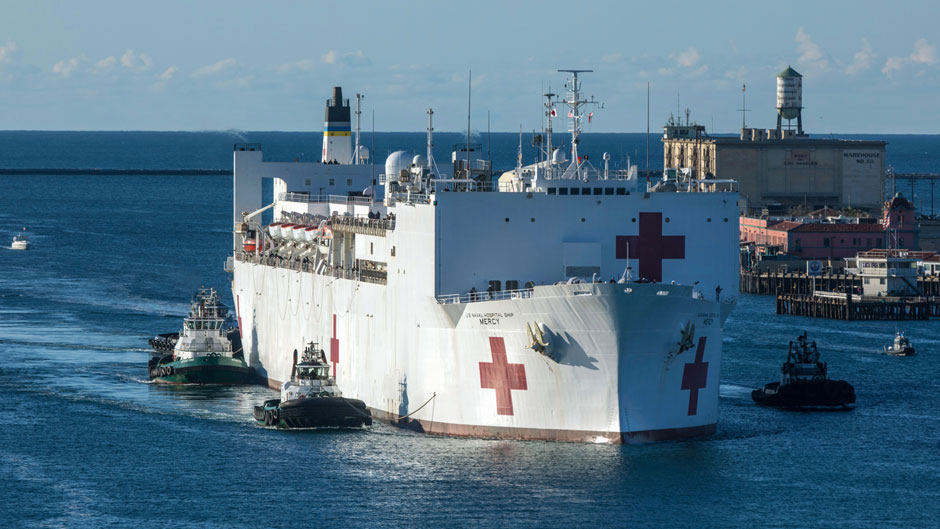As the massive ship USNS Mercy neared the Port of Los Angeles late last week, its white superstructure gleaming in the California sunshine, Captain John Rotruck, the chief medical officer of the nearly 900-foot long floating hospital, reflected on his time at the University of Miami.
Rotruck said his experience and training at Ryder Trauma Center at Jackson Memorial Hospital, while a medical student at the University, provided him with confidence and steeled him for deployments in Afghanistan, at Walter Reed National Medical Center, and now on the frontline of fighting a global pandemic.
“The supervised independence we received as medical students encouraged me to push my skills to their maximum possible extent,” Rotruck said in a telephone interview shortly after the ship docked in Los Angeles.
The Mercy, which will remain in Los Angeles indefinitely, will serve as a relief valve for Los Angeles hospitals, providing a full spectrum of medical care onboard that will let local hospitals better focus on COVID-19 patients.
 As commanding officer of the medical treatment facility that features 1,000 beds, including 80 intensive care units, Rotruck is charged with running the hospital services and overseeing the medical staff, which makes up roughly two-thirds of the nearly 1,000 personnel on board.
As commanding officer of the medical treatment facility that features 1,000 beds, including 80 intensive care units, Rotruck is charged with running the hospital services and overseeing the medical staff, which makes up roughly two-thirds of the nearly 1,000 personnel on board.
Working in conjunction with the Federal Emergency Management Agency, the State of California, and Los Angeles County, the Mercy began accepting its first patients Sunday.
“For the Navy and the military, a command tour is very different from anything you’ve ever done—you’re ultimately responsible for everything that happens,” Rotruck said. “You’re in a position to do good things, recognize hard work, and try to create conditions so that people who are under you can be successful.”
Rotruck grew up in Virginia Beach, Virginia. His father retired from the Navy and moved the family to Orlando, Florida, where Rotruck attended junior high and high school. To pursue his childhood dream to become a doctor, Rotruck applied for and was accepted into the University of Miami’s then extant Honors Program in Medical Education—two years of undergraduate study toward a biology or chemistry degree, followed by four years of medical school. He graduated with a Bachelor of Science degree in 1995 and a medical degree from the Miller School of Medicine in 1996.
While at the University, Rotruck was tapped into the Iron Arrow Honor Society. “An honoring and humbling recognition,” he recalled.
He joined the Navy to take advantage of educational benefits that offset the cost of his degree, intending to fulfill the four-year military commitment and then return to civilian life.
“In the Navy, I was exposed to opportunities and experiences that I never would have had otherwise—and here I am, almost 24 years in and with a few to go,” he said.
On entering the Navy, Rotruck completed his internship in internal medicine, followed by an operational tour with the Marine Corps in Southeast Asia and two tours as a flight surgeon. He then completed his anesthesiology residency and fellowship, and following his training served as the chief of cardiothoracic anesthesiology at the National Naval Medical Center. His deployments later included various tours in Southeast Asia, where he served as general medical officer and senior flight surgeon.
After a deployment in support of Operation Enduring Freedom, his colleagues elected him to be the president of the medical staff at the Walter Reed National Military Medical Center, the nation’s largest joint military medical center.
Though he was getting plenty of on-the-job training in health care leadership at the medical center, Rotruck sensed he needed additional skills to support his increased responsibility.
“I needed something more foundational like an M.B.A.—and the University of Miami was my first choice,” he said. He completed the two-year online program and earned his degree in 2017.
That decision paved the way for more advancements at Walter Reed and, ultimately, he was named chief of staff.
“That was the career milestone that enabled me to be selected for commands,” he explained. The USNS Mercy was his top duty choice. “I couldn’t have been happier when I was selected,” he said.
He and his wife flew to Sri Lanka to meet the Navy’s hospital ship where it was on deployment, and Rotruck assumed command in a ceremony off the coast of Vietnam in May 2018.
“There’s no other job in the military that gives you that much ability to try to develop professional skills and improve people's lives than being the commanding officer,” Rotruck said.

